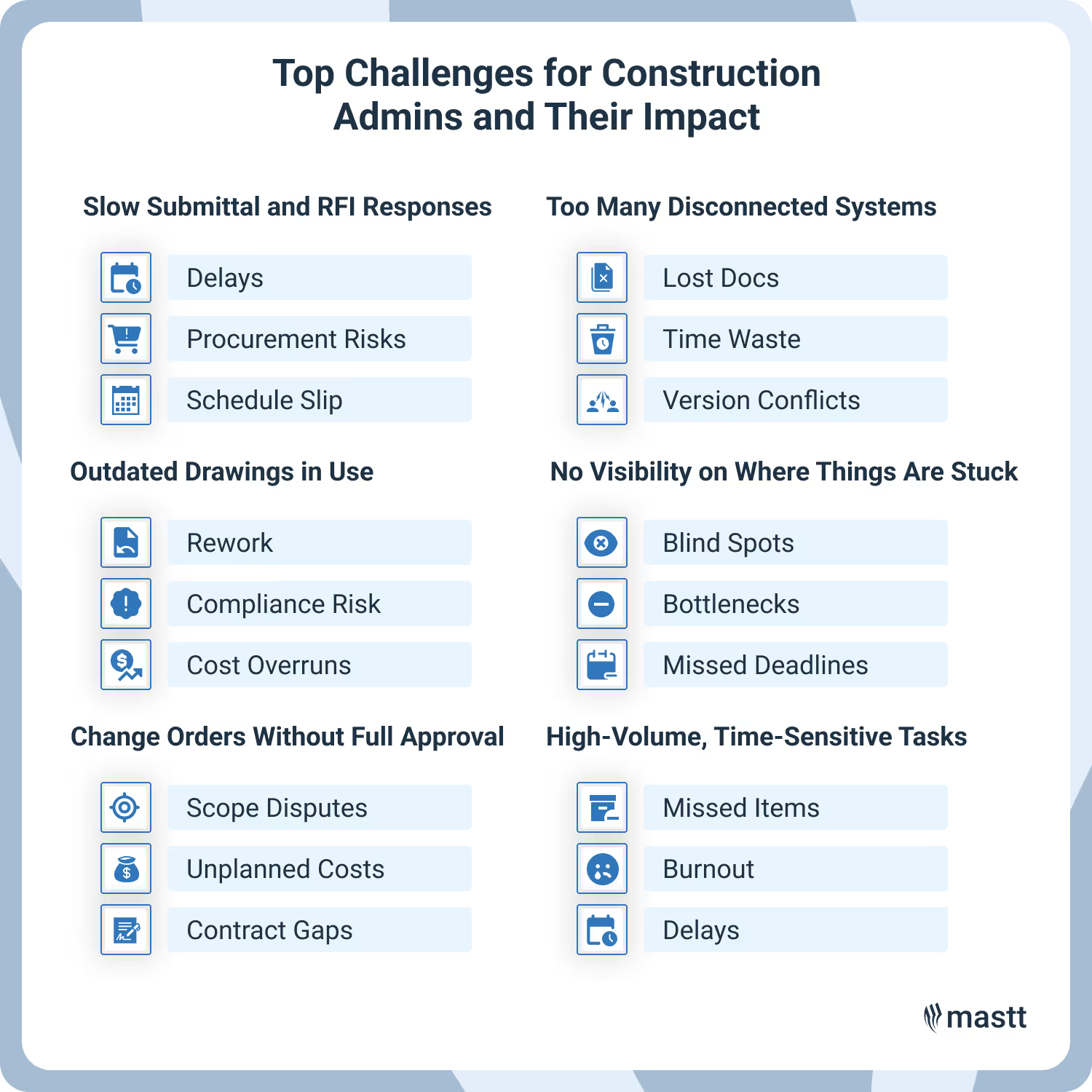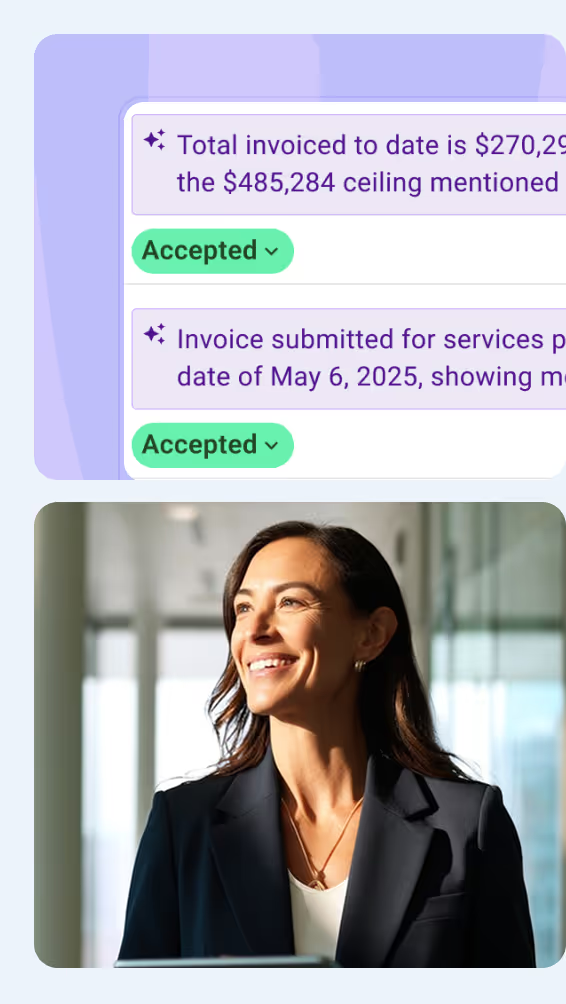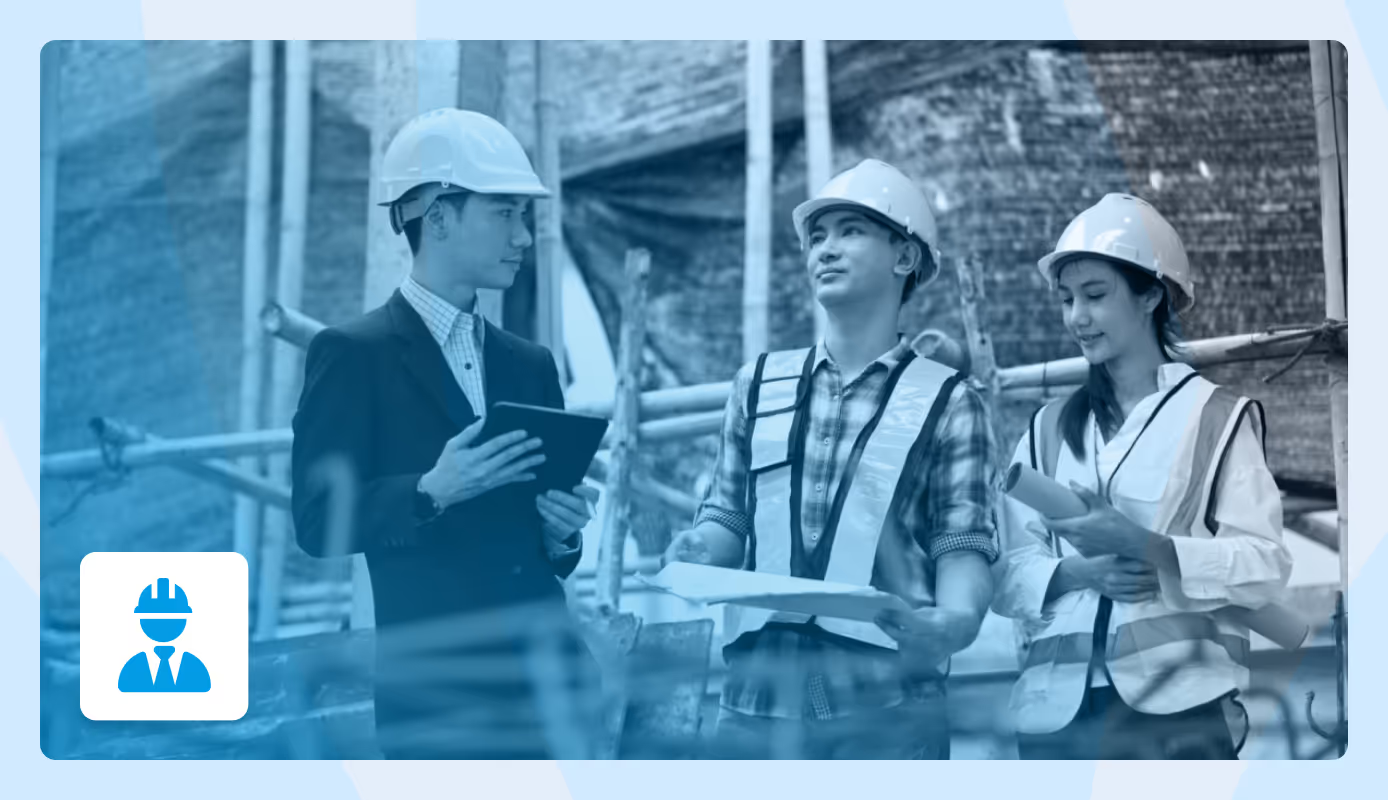A construction administrator manages the documents, processes, and approvals that support project delivery. They act as the central support system that keeps construction projects running smoothly from initial planning through final completion.
This article explains what the role involves, how it differs from similar positions, and what skills and experience are required. You'll also learn who construction administrators work with, what challenges they face, and how much they typically earn.
What is a Construction Administrator?
A construction administrator is a project team member who manages construction documents, contract communication, and compliance tracking. Their main role is to support contract administration by handling submittals, RFIs, change orders, and project records during the construction phase.
In this role, the focus isn’t on daily site work. Instead, it’s about keeping paperwork accurate, approved, and aligned with the construction contract. This includes keeping documents current, routing them for approval, and meeting both project and contractual requirements.
A construction administrator minimizes disputes, strengthens coordination, and ensures progress and payment are tied to verified work. Their detail-oriented work keeps projects efficient and protects stakeholders from costly mistakes.

What Does a Construction Administrator Do?
A construction administrator oversees the documents, workflows, and approvals involved in construction administration. This role ensures the project remains contractually accurate, organized, and compliant. They make sure information is submitted on time, reviewed appropriately, and properly recorded before work proceeds.
The construction administrator’s responsibilities typically include the following tasks:
- Track submittals: Monitor shop drawings, product data, and material samples, ensuring timely review and approval.
- Log RFIs: Route contractor questions to consultants and follow up on responses.
- Manage change orders: Record scope changes, confirm pricing, and issue updated contract documents.
- Control documents: Keep current drawings, specifications, and field reports accessible.
- Check contract compliance: Make sure work follows codes, approved documents, and contract terms and conditions.
- Prepare payment processing: Organize pay application backup, track progress payments, and manage retainage.
The construction administrator keeps communication clear and records traceable. For example, if a contractor submits a product that doesn’t match the approved spec, the administrator flags it before it delays the build. If scope changes mid-project, they ensure it’s priced, approved, and documented.

What is a Typical Day Like for a Construction Administrator?
A typical day for a construction administrator moves between reviewing communications, managing documents, attending project meetings, and keeping the project team aligned. They split their time between the office and site coordination, ensuring all information, approvals, and compliance records are accurate and up to date.
Morning: Setting Priorities and Reviewing Project Updates
The day begins by reviewing RFIs, site diaries, and emails from contractors, consultants, or suppliers. These updates reveal any urgent issues, design clarifications, or safety concerns that need attention.
The administrator then updates the task register and checks in with the construction project manager or site supervisor to confirm priorities.
Common morning tasks include:
- Reviewing daily site reports and contractor updates
- Responding to time-sensitive RFIs or approval requests
- Updating project logs, registers, and task trackers
- Checking the construction master schedule for upcoming project milestones or inspections
High-impact items get a response target, often within 4 to 24 hours. RFIs with schedule impact are tagged and assigned immediately.
Late Morning: Managing Project Documents
Late morning often shifts to document control and drawing management. Updated construction drawings are distributed to relevant subcontractors, while any revisions are logged in the document register. The administrator also reviews and approves submittals before they move forward.
Typical activities include:
- Uploading and sharing the latest drawings via the project management platform
- Reviewing shop drawings, material submittals, and technical data sheets
- Following up with engineers or consultants on outstanding queries
- Updating the document control system to reflect approved changes
Each revision receives a transmittal number and distribution list. Version control rules block outdated drawings from the site. Hold points and inspection plans are attached to the relevant sheets.
Midday: Coordinating with the Project Team and Stakeholders
Around midday, it’s time for coordination meetings. These might be project control group (PCG) meetings, site briefings, or client progress reviews. The administrator participates in capturing actions, flagging construction project risks, and facilitating communication between trades, consultants, and the owner’s team.
In these meetings, they may:
- Record minutes and distribute them promptly to all attendees
- Highlight compliance, safety, or schedule risks needing attention
- Connect site teams with design or procurement teams for technical clarifications
Decisions are timed, usually 15 to 30 minutes per item. Actions are recorded in the minutes, including the owner and due date. Risks update the register with trigger and response.
Afternoon: Handling Contracts, Payments, and Compliance Tasks
The afternoon often focuses on contract-related administration and compliance reporting. This means preparing and reviewing progress payments, issuing payment certificates, and updating cost forecasts. Each document must meet contractual requirements and be recorded in the project’s audit trail.
Tasks in this period can involve:
- Drafting progress payment certificates for contractor payments
- Uploading compliance documentation, including safety and environmental reports
- Updating cost registers with approved payments and change orders
- Reviewing contract deliverables for deadlines and acceptance criteria
Progress payments follow a checklist for scope, quantities, evidence, and approvals. The administrator performs a three-way match against logs and the schedule. Cost forecasts are updated after each approved change.
End of Day: Final Checks and Planning Ahead
Before signing off, the administrator reviews the day’s progress and prepares for the next. Registers are updated, follow-up items are listed, and the project dashboard is checked for outstanding approvals or overdue tasks. A quick scan of the inbox ensures nothing urgent is left unresolved.
This review often includes:
- Updating registers with final actions and changes
- Preparing tasks and meeting agendas for the next day
- Sending concise updates to the project manager or client representatives
Logs are reconciled against emails, minutes, and site reports. Tomorrow’s priorities are posted to the dashboard by 5 p.m. Alerts are set for approvals, inspections, and deliveries.
What Skills Do You Need to Be a Construction Administrator?
A construction administrator needs both technical and soft skills to manage a construction project. The role involves a high level of coordination, so staying accurate and organized is key.
The table below shows the core skills used daily in construction administration:
Good construction administrators know how to balance structure with flexibility. They can spot a missing drawing revision just as easily as they can chase a late RFI. What sets them apart is their ability to stay calm under pressure, communicate clearly, and keep every detail tied to the contract.
What Challenges Do Construction Administrators Face on the Job?
Construction administrators often deal with slow approvals, incomplete documents, and disconnected systems. Their biggest challenges come from managing high volumes of information under tight timelines.
Here are the common problems a construction administrator faces:
- Slow submittal and RFI responses: Reviews can take days or weeks. Admins need to follow up constantly to avoid holding up procurement or site work.
- Outdated drawings in use: If the site team builds off an old set, it leads to rework. Admins must keep version control tight.
- Change orders without full approval: Work sometimes starts before paperwork is approved. Admins have to clean it up to match contract records.
- Too many systems in use: Emails, spreadsheets, shared folders, and project software don’t always sync. Documents get missed.
- No visibility on where things are stuck: When a document stalls, it's not always clear who’s holding it or what’s missing.
- High-volume, time-sensitive tasks: Admins handle dozens of tasks a day. One missed item can delay payments, inspections, or payments.
Many of these problems come from working across disconnected tools, manual trackers, and unclear workflows. With Mastt, construction administrators can manage documents, approvals, and payments in one place. It simplifies tracking, improves visibility, and helps teams work with the most current project data.

What are the Pros and Cons of Being a Construction Administrator?
The construction administrator career offers an excellent entry point into the construction industry with hands-on experience and transferable skills. However, it demands meticulous attention to detail and involves high-stress deadlines.
The role of a construction admin varies by project size, though. On smaller jobs, administrators handle the entire workflow. On larger construction projects, tasks are more specialized and focused.
How to Become a Construction Administrator
Most construction administrators get the role through study and experience. Some start with formal qualifications, others progress from site or office support roles. The aim is to understand construction processes, contract requirements, and the flow of information between stakeholders.
Here are the common steps to get started in the construction administrator role:
- Get a relevant qualification: Most have a diploma or degree in construction management, architecture, engineering, or a related field.
- Start in a support role: Entry-level experience as a project assistant, site administrator, or document controller helps build the right skills.
- Learn project systems: Get familiar with tools like Mastt, Procore, and Excel. Most work happens inside these platforms.
- Understand contract basics: Know how to read scopes, identify changes, and follow up on approvals.
- Develop communication habits: Construction admins work with multiple people daily. Clear written and verbal updates are key.
- Move into the role: After 1-3 years in support roles, many transition into construction administrator or project coordinator positions.
Some construction admins start with site experience. Others come from admin or support roles and learn construction project management workflows on the job. If you understand how information flows from design through to payment, you're already close to what the role demands.
How Much Does a Construction Administrator Earn?
Construction administrators typically earn between $46,165 and $100,966 USD per year, depending on location. The role is in demand across public and private projects, with stable pay and a clear path toward coordinator or PM-level roles.
Here’s what the numbers show by country:
- United States: Average base salary is $68,272 USD.
- Australia: Average base salary is $69,242 AUD.
- United Kingdom: Average base salary is £27,047.
- Canada: Average base salary is $54,416 CAD.
- Singapore: Average base salary is SGD 32,703.
Pay increases with experience. Junior admins handle logs and basic tracking. Mid-level admins manage submittals, RFIs, and contract workflows. Senior admins take on payments, change orders, and compliance oversight. As responsibilities grow, so does the salary.
Who Does a Construction Administrator Work With?
Construction administrators work with project managers, site teams, consultants, and internal stakeholders. Here are the key roles a construction administrator interacts with:
- Project Owners or Clients: Receive key reports, approve payments, and sign off on major changes.
- Project Managers (PMs): Coordinate on RFIs, submittals, and change approvals.
- Assistant Project Managers (APMs): Share admin workloads and document control tasks.
- Site Supervisors or Superintendents: Provide updates on work progress and ensure site teams are using current documents.
- Design Consultants (Architects, Engineers): Review and respond to submittals and RFIs.
- Contract Administrators: Collaborate on approval workflows, compliance checks, and commercial documents.
- General Contractors: Coordinate contract deliverables, consolidate subcontractor documentation, and respond to RFIs, submittals, and change order requests.
- Vendors and Subcontractors: Request missing documentation and confirm scope or project delivery timelines.
Construction Administrator vs. Contract Administrator: What’s the Difference
A construction administrator manages the flow of documents, approvals, and project records. A contract administrator focuses on contract compliance, commercial terms, and scope changes. The titles sometimes overlap, but the responsibilities are different.
Here’s how the two roles compare:
On large builds, contract administrators often sit within client-side project management, while construction administrators remain with the project delivery team. They cross paths on change orders, payment reviews, and anything that needs both contract terms and supporting records.
Make Construction Administration Easier with AI
AI can take over repetitive admin work such as logging RFIs, tracking submittals, and updating change orders. This shift frees you to focus on validating information, coordinating teams, and ensuring documents meet contract requirements.
Construction administrators who pair these tools with strong contract knowledge become faster, more accurate, and harder to replace.
















